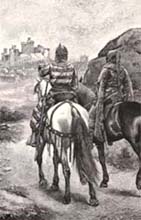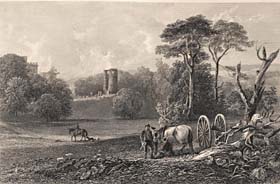|
|
Home | Corson Collection | Biography | Works | Image Collection | Recent Publications | Portraits | Correspondence | Forthcoming Events | Links | E-Texts | Contact Castle Dangerous(Tales of My Landlord, Fourth Series)First Edition, First Impression: Tales of My Landlord, Fourth and Last Series. Collected and Arranged by Jedediah Cleishbotham, Schoolmaster and Parish-Clerk of Gandercleuch. In Four Volumes. Vol. I (II-IV). Printed for Robert Cadell, Edinburgh; and Whittaker and Co., London, 1832. Composition | Synopsis | Reception | Links
As he worked on the novel, Scott became dissatisfied with his descriptions of the Douglas area, which he had not visited since childhood. He thus journeyed to Lanarkshire with Lockhart hoping to refresh his impressions of the ruined castle and Douglas church and to pick up local traditions and customs. In his biography of his father-in-law, Lockhart records his distress at the waning of Scott's mental powers and memory that became evident to him during this trip. Scott was slightly better pleased with Castle Dangerous than with its longer companion piece Count Robert. The two novels were published together on December 1, 1831 as the Fourth Series of Tales of My Landlord. SynopsisCastle Dangerous is set in 1306 during the Wars of Independence. An English heiress Lady Augusta de Berkely has promised to marry Sir John de Walton if he can defend the strategically vital Castle Douglas against the forces of Robert the Bruce and Sir James Douglas (the 'Black Douglas') for a year and a day. Increasingly alarmed, though, by the danger he is running, she travels to Douglasdale in masculine disguise, accompanied by an old minstrel, Bertram. She takes up residence in the Convent of St. Bride where she immediately falls under suspicion of being a spy. When Sir John demands that the mysterious youth be brought to Castle Douglas for questioning, Augusta flees in shame and blunders into the hands of Sir James Douglas. When her true identity is revealed, Douglas refuses to deliver her to Sir John unless he surrender the castle. Sir John refuses and engages in personal combat with Douglas. Still unresolved, their conflict is ended by an order from Sir John's defeated ally, the Earl of Pembroke, to surrender the castle. Douglas chivalrously restores Lady Augusta to Sir John and, although he has been unable to fulfil her conditions, she accepts his hand.
ReceptionScott was astonished by the commercial success of Castle Dangerous and Count Robert, neither of which he had deemed 'sea worthy'. He thought the public 'mad for passing thes[e] two volumes' (Journal, 16 (or 26) January 1832) but began to hope that he might at last be able to write himself out of debt. For critical reaction, see the page devoted to Count Robert of Paris. Links
Last updated: 19-Dec-2011 |
|||


